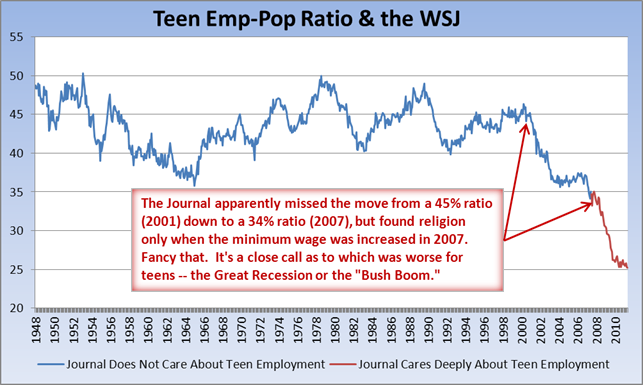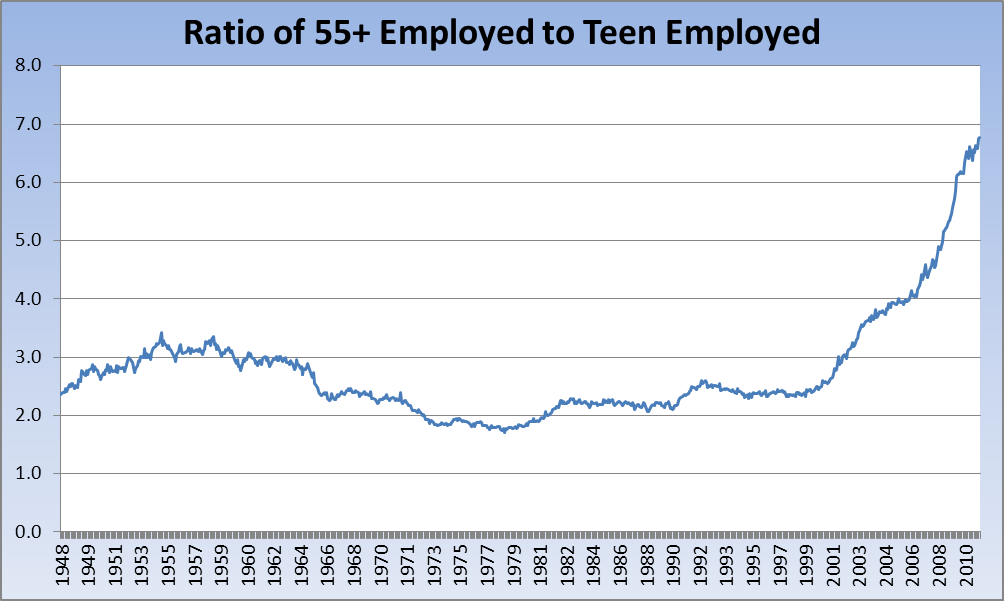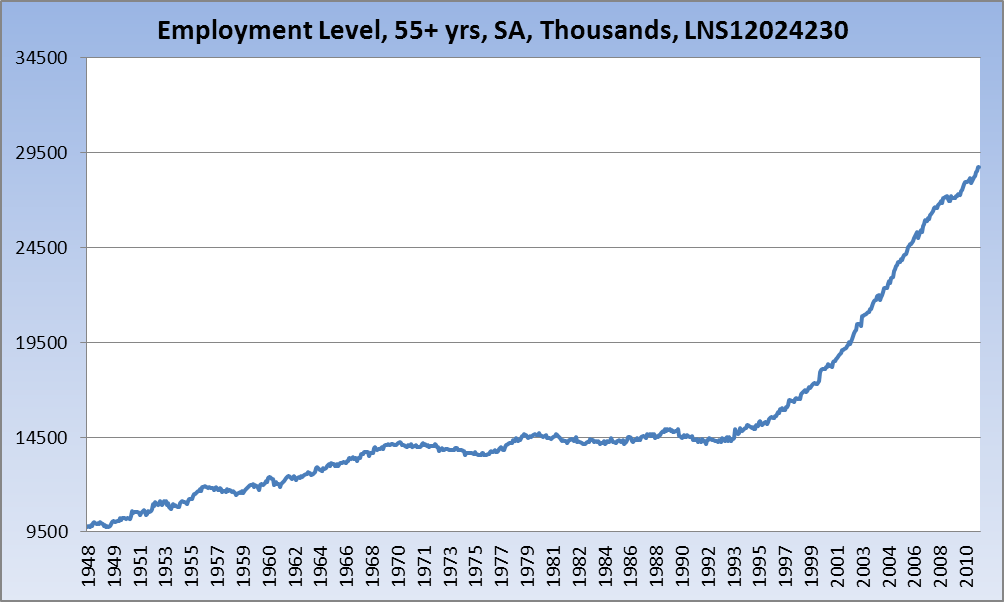By Invictus
The Wall St. Journal’s editorial page weighed in Friday with a somewhat laughable piece (my title was their sub-hed) on how the 2009 increase in the minimum wage has decimated employment for the 16-19 year old cohort (since 2001). Except for a few inconvenient facts.
As the Journal is quick to point out:
Only 24% of teens, one in four, have jobs, compared to 42% as recently as the summer of 2001.
How a minimum wage increase that was enacted first in 2007 is responsible for a teen employment/population ratio that has been declining since 2001 — throughout the other guy’s entire presidency, in fact — is not addressed. Where was the Journal as the rate declined from 44.6 when Bush took office to 30.6 when he left? Where were they when it made a historic low under Bush’s watch (August 2008)?
Journal:
Back on planet Earth, the minimum wage increase has coincided with the plunge in the percentage of working teens. Before the most recent wage hikes, roughly seven million teens were working. Now there are closer to five million with a job and paycheck.
That statement is, sadly, simply false. At the time “before the recent wage hikes” (July 2007), there were 5.888 million teens employed (BLS Series LNS12000012). There are now 4.240 million employed. There have not been “seven million teens” working since the early months of the Bush administration. As for when “the plunge” actually began, see for yourselves:

Source: BLS.gov
The plunge — which began on Bush’s watch and continued through his “boom” — took place during a period when the minimum wage was $5.15/hour and was not raised until 2007. No explanation for that inconvenient fact. Or the inconvenient fact that the teen employment/population ratio rose after the Sept. 1997 increase in the minimum wage to$5.15 (where it stayed until a decade later, when it went to $5.85).
And why only gloss over the fact that teens, generally, are not eligible to make minimum wage in the first place:
Must young workers be paid the minimum wage?
A minimum wage of $4.25 per hour applies to young workers under the age of 20 during their first 90 consecutive calendar days of employment with an employer, as long as their work does not displace other workers. After 90 consecutive days of employment or the employee reaches 20 years of age, whichever comes first, the employee must receive a minimum wage of $7.25 per hour effective July 24, 2009. [Ed note: This would seem to me to cover summertime employment.]
Other programs that allow for payment of less than the full federal minimum wage apply to workers with disabilities, full-time students, and student-learners employed pursuant to sub-minimum wage certificates. These programs are not limited to the employment of young workers.
What minimum wage exceptions apply to full-time students?
The Full-time Student Program is for full-time students employed in retail or service stores, agriculture, or colleges and universities. The employer that hires students can obtain a certificate from the Department of Labor which allows the student to be paid not less than 85% of the minimum wage. The certificate also limits the hours that the student may work to 8 hours in a day and no more than 20 hours a week when school is in session and 40 hours when school is out, and requires the employer to follow all child labor laws. Once students graduate or leave school for good, they must be paid $7.25 per hour effective July 24, 2009.
Oh, and one other thing: The Emp-Pop Ratio for the 55+ cohort (which dwarfs the 16-19 cohort) was on the rise from 1993 through 2008, and has not budged much since then. Demographics do not seem to figure into the Journal’s hypothesis.

Source: BLS.gov
Here’s the ratio of 55+ Employed to Teen Employed. You may notice somethin’ happenin’ here, what it is is exactly clear — in 2001, the exact year referenced by the Journal, the first of the boomers (born in 1946) turned 55. The rest is history:

Source: BLS.gov, analysis
This as the 55+ Employed cohort has grown by over 10 million, from 18.5 million in 2001 to 28.7 million recently:

Shame on the Journal for trotting out this nonsense yet again. It’s embarrassing and, frankly, such hackery should be beneath them. Really, enough already. Please stop. Sigh.
I’ve written previously about this here (almost two years ago), to cite but one of my earlier critiques of this argument.
No comments:
Post a Comment